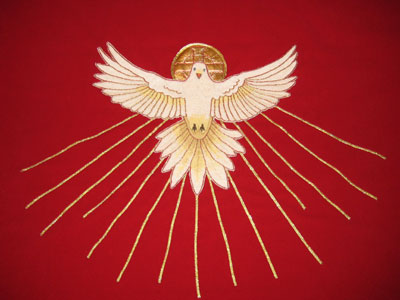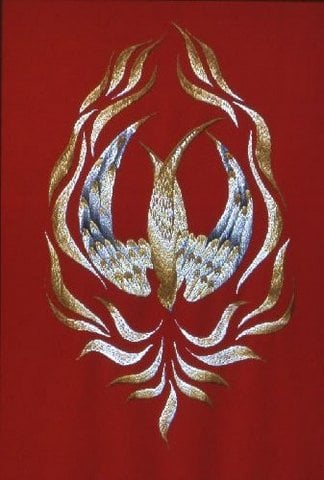Catholic art is not just there to be pretty, it is there to preach, or rather it is attractive because it has something profound and beautiful to say. I remember somebody once referring to the Holy Spirit rather condescendingly as simply a "bird", pointing out just how weak the symbolism is. In fairness, he was trying to encourage a more interesting discussion surrounding the Holy Spirit by suggesting that we could do a lot better than offering forth a "boring old bird" as the third Person of the Blessed Trinity.
Nevertheless, I would suggest that the problem isn't the "bird", but the lack of an artistic imagination on the part of those who behold this image. The key is to see these winged creatures as a child sees them. The creature isn't boring, we are. When we were children and saw a swallow ascending like a kite, who among us did not take flight with them? And what about those stories we heard as children (and the pictures we saw) of those ancient birds known as pterodactyls? What about the hummingbird, or the bluebird (on our shoulder, as it were)? And how "boring"is it to take a flight in a dream, or on a plane or in a parachute for that matter?
I say this not because it is always easy for me to come up with an inspiring images for the Holy Spirit, but because I too must do the "leg work" of the imagination if I'm going to be inspired with gratitude for the Spirit.
Consequently, what I observed from the choir loft this past Pentecost gave me quite a head start in this department. High above the congregation, and far from the priest and the altar, I experienced one of the most magnificent gestalt-switches imaginable, a trick of the eye that immediately provoked a deeper contemplation of the Holy Spirit. Maybe it was my imagination, or maybe it was intended by the creator of the iconographic image (or maybe it was some combination of both). What is irrefutable is the fact that it deepened my gratitude for the Holy Spirit.
WHAT I SAW FROM THE CHOIR LOFT:
First of all, while casually observing the priest from the choir loft, what I perceived on his chasuble was what seemed to my eyes to be the Holy Spirit "dive-bombing" humanity. When Jesus was baptized in the river Jordan, Scripture says that the heavens were "torn open" and the Spirit descended like a dove. Notice, Scripture never claims that the Spirit is a dove as such. Rather, the Gospels say that the Holy Spirit descended "like" a dove. At any rate, in this context the image struck me with incredible force, the notion that the Holy Spirit- like some youth waiting to get into a rock concert- rushing forth in a riot of divine energy, as the gates of heaven are torn asunder. Indeed, what a mind-blowing paradox, the dove of peace, appearing almost (as in the photo below) like some sort of divine arson.
Secondly, I observed something of which I am far less certain, but which is nevertheless the very thing that inspired this post in the first place. Because I was so far away from the altar, my imagination (and eyes) were able to take a little impressionistic journey. Indeed, as I squinted to look at the vestment, it occurred to me that not only was the Spirit "dive-bombing humanity," but the image also revealed something quite opposite, though anything but contradictory.
Much like those images that reveal one thing when you look at them one way, and something quite different when you look at them another (see above image), so also for me at the Mass that day. Yes, there was a dove facing downward, but as I looked a little bit longer, I also observed what appeared to be a kind of Firebird facing upward. Immediately I was reminded of images I had seen somewhere depicting the mythical creature known as the Phoenix rising from its ashes. In this upside down Gestalt, what was formerly the tail, now appeared to me to be the head tilted to the side, and what was previously the head of the dove, now represented the ashes from whence this mystical bird arose.
Thus, it dawned on me that the gates of heaven were not just "torn open" so that the Holy Spirit could rush upon us, but that we too, like the Spirit, could ourselves storm heaven. Was it a dream, or are my theological instincts correct? Quite possibly both. For in Baptism it has been revealed that we too will receive the "wings" of the Spirit. Indeed, is this not the whole point of the dogma of the Ascension, as well as the Assumption? As a matter of fact, if all of these theological dogmas are true, then we too should one day expect to soar into the choir loft of heaven, we too should expect to rise from the ashes of our demise, singing for joy, not like some "boring old bird", but rather like those beautifully terrifying and exotic creatures described in myths of old, as well as the ones detailed by John in the Book of Revelation.













